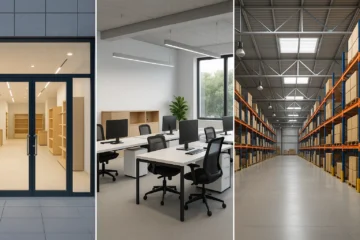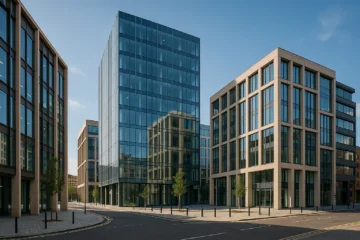The UK’s commercial property sector is shifting gears—and quickly. With hybrid work now a fixture, the economy treading a cautious recovery, and tenants rethinking what they really need, flexibility has become the name of the game. While forecasts show steady growth through 2025, the real momentum depends on how businesses and investors navigate these changing tides.
Back on Its Feet—And Wiser for It
After a stretch of turbulence, commercial real estate is building back—this time with sharper instincts. While the high street still faces some pressure, demand is surging for modern offices, logistics hubs, and versatile developments. More companies are eyeing cities like Leeds, Manchester, and Birmingham, lured by strong transport links and better value outside London’s price bubble.
Space planning, too, has matured. It’s not just about square footage anymore—it’s about how the environment supports teams, aligns with values, and prepares for what’s next.
Leases That Work Harder
In real estate, the lease can make or break a business.
Take Theo from Nottingham. He almost signed a rigid 10-year lease—no break clause, no flexibility. A property consultant stepped in, and they reshaped the deal: five years, options to renew, and a tenant allowance. “That flexibility saved us,” Theo says. “When costs rose, we had space to adapt.”
It’s a classic example: a lease isn’t just paperwork. It’s a lever for growth—or a liability if mishandled.
Tenants Taking the Wheel
These days, landlords are upping their offers to win reliable tenants. More flexible terms, customised spaces, and incentives like rent holidays are becoming standard fare.
For growing firms, leasing still trumps ownership—it’s agile, capital-light, and easier to pivot. Looking ahead, a hybrid path is emerging: lease first, plan for ownership later, and sometimes collaborate with developers along the way.
Big Names, Smaller Footprints
Even major corporates are rethinking real estate. Large, underused HQs are giving way to smaller, strategic hubs across the UK. It’s part cost-saving, part talent strategy, and part employee wellbeing.
As a result, new metrics are taking centre stage—like carbon output per desk, commuting time, and ESG alignment. The future workplace isn’t just smaller—it’s smarter.
Policy, Prices, and the Bigger Picture
The regulatory landscape is catching up. From stricter green codes to tenant-focused reforms and fresh tax incentives, legislation is shaping how leases are written and properties developed.
Economics add another layer: inflation, interest rate hikes, and geopolitical uncertainty are affecting everything from rent forecasts to construction timelines. The best-positioned players? They’re blending gut feel with solid data—and planning two steps ahead.
Startups Making It Work
For startups and SMEs, the commercial real estate world can feel daunting. But many are proving that starting lean and flexible pays off.
Like the two Brighton founders who kicked off with a shared desk and a month-to-month lease. When investment landed, they moved just down the hall into their own suite. Their story’s a testament: you can scale steadily—without overcommitting.
The Future Is Fluid
Yes, commercial real estate is growing—but it’s not business as usual. Success won’t be measured in square footage, but in adaptability. The standouts will be spaces that evolve: hybrid-friendly, wellbeing-focused, digitally wired.
Landlords who adapt their leases—not just their buildings—will earn trust, not just rent.
In a market that won’t sit still, understanding your lease, reading the signs, and keeping your space strategy flexible is key. Because those who stay nimble? They won’t just survive—they’ll shape what’s next.


